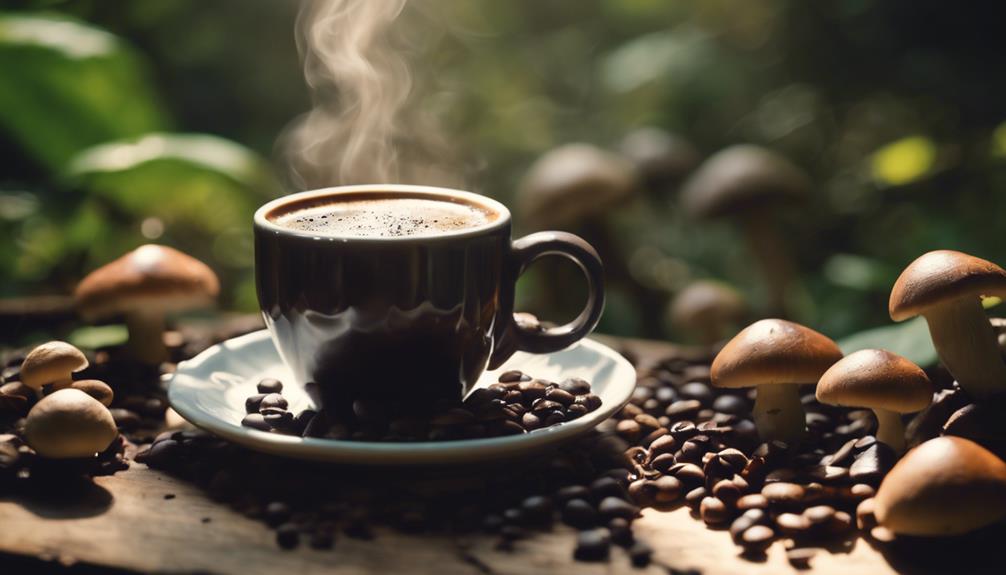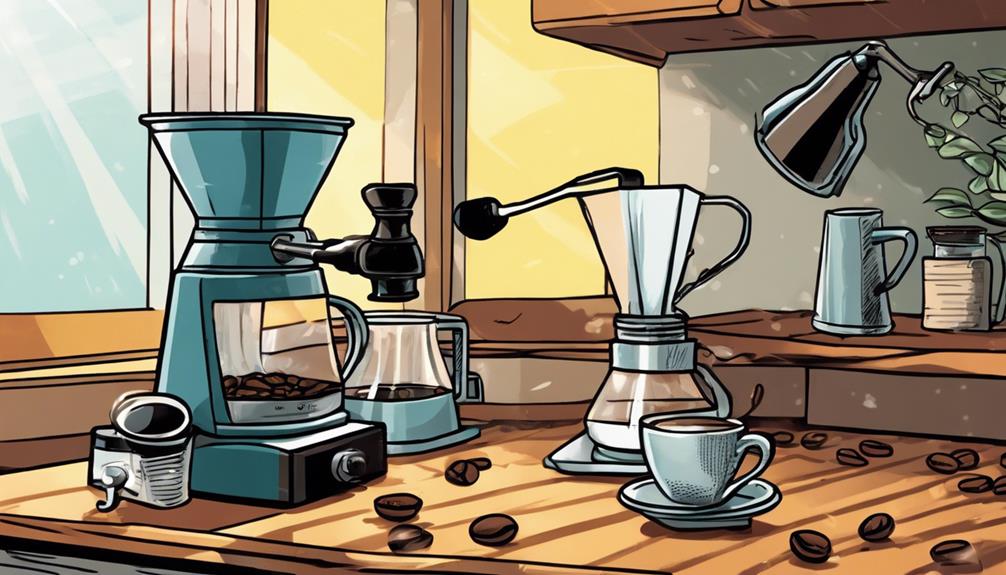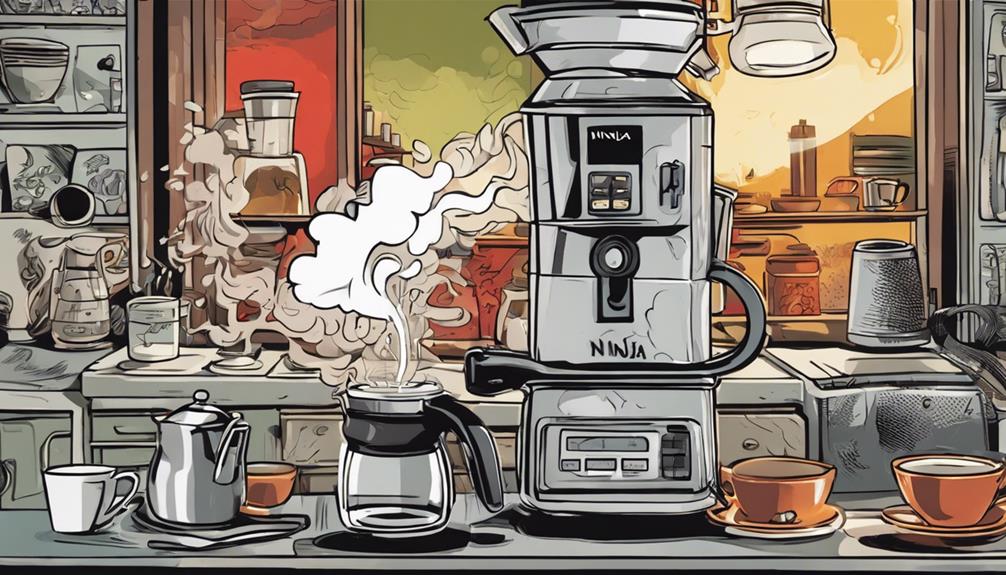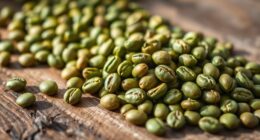To properly put together your coffee maker, begin by grinding the coffee to a consistency similar to table salt. Use 1 to 1.5 tablespoons for each shot and grind right before brewing. Remember to check important parts like the filter and O-ring for a secure fit. Then, keep the brewing temperature at 200°F and spread the grounds evenly. When the pressure is smoothly released, pour carefully. Select the correct pot size and filter, clean the parts after every use, and use mild cleaning products to maintain quality. Becoming proficient in this procedure will result in a delightful cup of coffee!
Key Takeaways
- Ensure silicone O-ring is in place for a tight seal.
- Fill water compartment appropriately for brewing pressure.
- Place coffee filter with pinholes securely in the brewing chamber.
- Tighten all components properly before brewing.
- Monitor safety valve for proper pressure release during brewing.
Understanding Moka Pot Basics
To make a great cup of coffee with a Moka pot, you must first grasp the fundamental basics of how this stovetop coffee maker operates. One key aspect to master is how to grind coffee.
The grind size for a Moka pot is essential; it should be finer than drip coffee but not as fine as espresso. The ideal grind consistency is similar to table salt. Using the correct grind size guarantees optimal extraction during the brewing process.
When grinding coffee for a Moka pot, a burr grinder is recommended for a more consistent grind size. Blade grinders can result in uneven grounds, affecting the flavor and extraction.
Measure out the coffee beans needed for your brew, typically around 1 to 1.5 tablespoons per espresso shot. Grind the coffee just before brewing to preserve its freshness and aroma.
Understanding the significance of grinding coffee to the right consistency sets the foundation for a delicious cup of Moka pot coffee.
Identifying Key Components
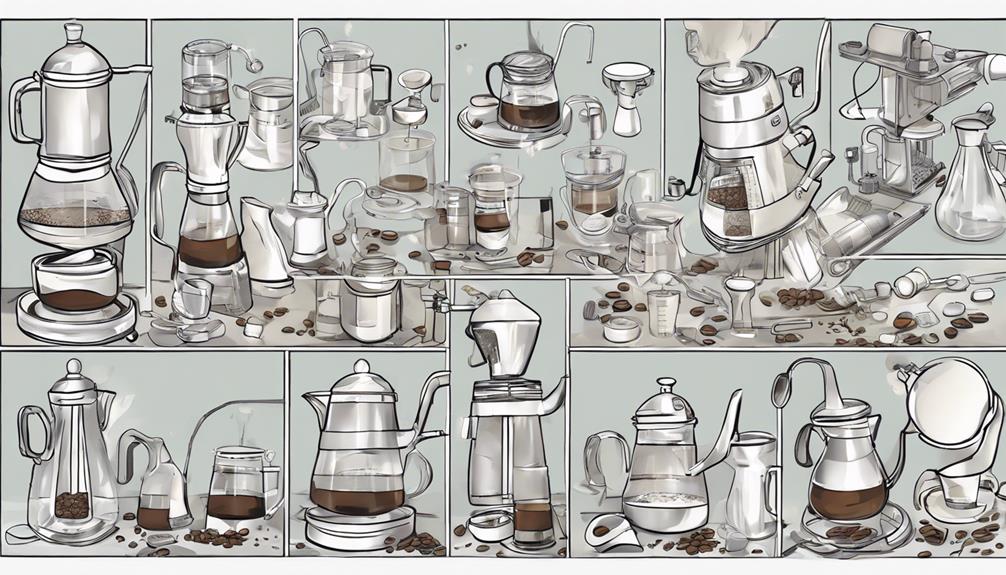
You need to understand the functions of each key component to successfully assemble a Moka pot.
The filter with pinholes, silicone O-ring, water compartment, brewing chamber, and safety valve all play essential roles in brewing your coffee.
Familiarizing yourself with these components will guide you through the assembly steps for a delicious cup of coffee.
Component Functions
Understanding the key components of a Moka pot is essential for assembling it correctly. The coffee filter is a crucial element of the Moka pot, designed with pinholes that allow the espresso powder to pass through during the brewing process. The silicone O-ring plays a vital role in creating a tight seal between the two main pieces of the Moka pot, ensuring proper pressurization. The water compartment is where you fill the water that will be heated to generate the pressure needed for brewing coffee. The brewing chamber is where the coffee grounds are placed, and it collects the brewed coffee as the process unfolds. Lastly, the safety valve is an important component that prevents any dangerous pressure build-up inside the Moka pot while brewing.
| Component | Function |
|---|---|
| Coffee Filter | Allows espresso powder to pass through during brewing. |
| Silicone O-ring | Creates a tight seal between main pot pieces for proper pressurization. |
| Water Compartment | Holds water that is heated to create brewing pressure. |
| Brewing Chamber | Where coffee grounds are placed and brewed coffee collects. |
| Safety Valve | Prevents pressure build-up inside the Moka pot during brewing. |
Assembly Step Guide
Identifying the key components of a Moka pot is necessary before proceeding with the assembly process. Here are the key components you need to know:
- Filter with Pinholes:
This is where you place your coffee grinds. The filter allows water to pass through the coffee, extracting its flavors to brew your espresso.
- Silicone O-Ring:
The O-ring is essential for creating a tight seal between the top and bottom chambers of the Moka pot. It guarantees that no liquid leaks out during the brewing process.
- Water Compartment:
This is where you pour water into the Moka pot. It's recommended to fill it up to the bottom of the safety valve to secure proper brewing and prevent any accidents.
- Brewing Chamber:
The brewing chamber is where the magic happens. This is where the coffee grinds steep in the hot water and produce the delicious espresso that you crave.
Mastering the Brewing Technique
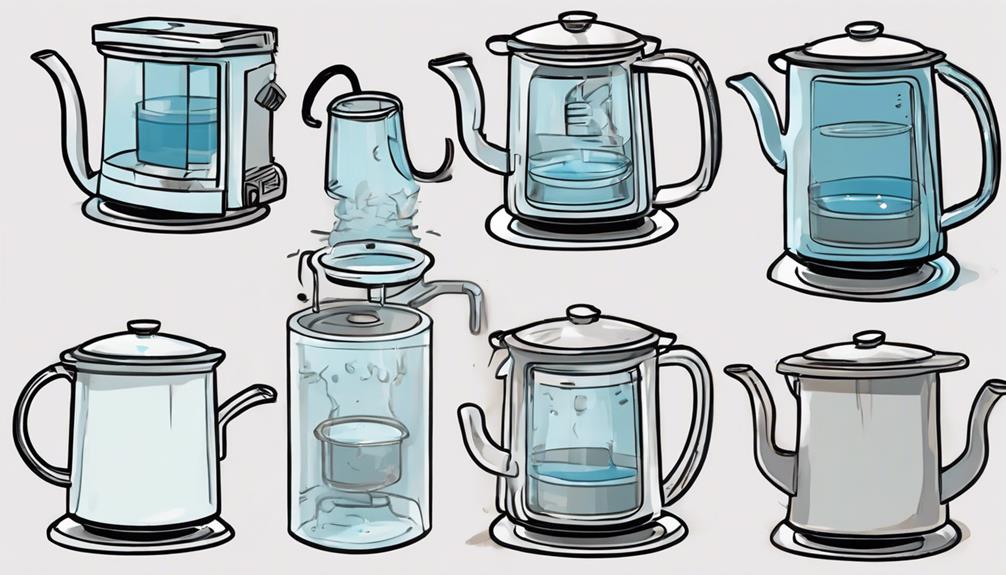
To master the brewing technique, you need to focus on controlling the temperature, distributing the coffee powder evenly, and monitoring the pressure release.
These three key points are essential in ensuring a perfect cup of coffee from your Moka pot.
Brewing Temperature Control
Maintain ideal brewing temperature in your Moka pot by slowly heating it on a low flame to prevent overheating and scorching the coffee. This careful supervision guarantees that your coffee extracts the best flavors from the grounds, resulting in a delicious and aromatic brew.
To master the brewing temperature control in your Moka pot, follow these tips:
- Gradual Heating: Start with a low flame to gradually bring the pot to the ideal temperature without risking overheating.
- Optimal Temperature: Aim for around 200°F (93°C) to achieve the perfect balance of flavors from your coffee grounds.
- Avoid High Heat: Steer clear of high heat settings that can scorch the coffee, impacting the taste and quality of your brew.
- Consistent Monitoring: Keep a close eye on the brewing temperature to control the extraction process effectively and guarantee a rich and balanced coffee flavor.
Coffee Powder Distribution
Properly spreading fine espresso powder in your Moka pot is vital for achieving a rich and flavorful coffee concentrate. When it comes to coffee powder distribution, using fine espresso powder is pivotal as it allows for proper extraction through the small holes in the filter.
To ensure ideal brewing, it's essential to distribute the coffee powder evenly and compactly. This even distribution helps create a tight 'puck,' which controls the flow of water during the brewing process and enhances the extraction of flavors from the coffee grounds.
Mastering the technique of distributing the coffee powder in your Moka pot is fundamental to brewing a perfect cup of coffee. By compacting the powder correctly, you set the stage for a well-balanced and delicious brew.
Pressure Release Monitoring
Monitoring the steam release during brewing in your Moka pot is critical for achieving the ideal pressure and temperature needed to extract the full flavors of your coffee. Proper pressure release guarantees a balanced and flavorful brew without the risk of accidents.
Here's how to effectively monitor the pressure release:
- Check the Valve: Confirm the pressure release valve is clean and free of any blockages that could impact its function.
- Listen for Consistent Steam Release: Pay attention to the sound of steam escaping from the valve. A steady release indicates proper pressure control.
- Observe Steam Intensity: The steam should be released gently and continuously throughout the brewing process, maintaining the right pressure level.
- Adjust Heat Source if Needed: If the steam release is too weak or too strong, adjust the heat source to regulate the pressure inside the Moka pot effectively.
Mastering the art of pressure release monitoring is crucial to brewing exceptional coffee with your Moka pot.
Perfecting the Serving Process

To perfect the serving process of your coffee brewed in a Moka pot, ensure the coffee oozes out smoothly resembling melted chocolate before pouring. This secures the best flavor extraction, enhancing your coffee experience. Here is a simple guide to help you serve your freshly brewed Moka pot coffee like a pro:
| Serving Process Tips |
|---|
| Wait for coffee to ooze out smoothly like melted chocolate before pouring. |
| Use a heat-resistant surface to prevent accidents when handling the hot Moka pot. |
| Brew time is around 2 minutes for quick and efficient serving. |
| Moka pots typically yield 3-4 cups of rich, aromatic coffee. |
| Mastering the serving process is crucial for the perfect cup of Moka pot coffee. |
Determining Brew Quantity
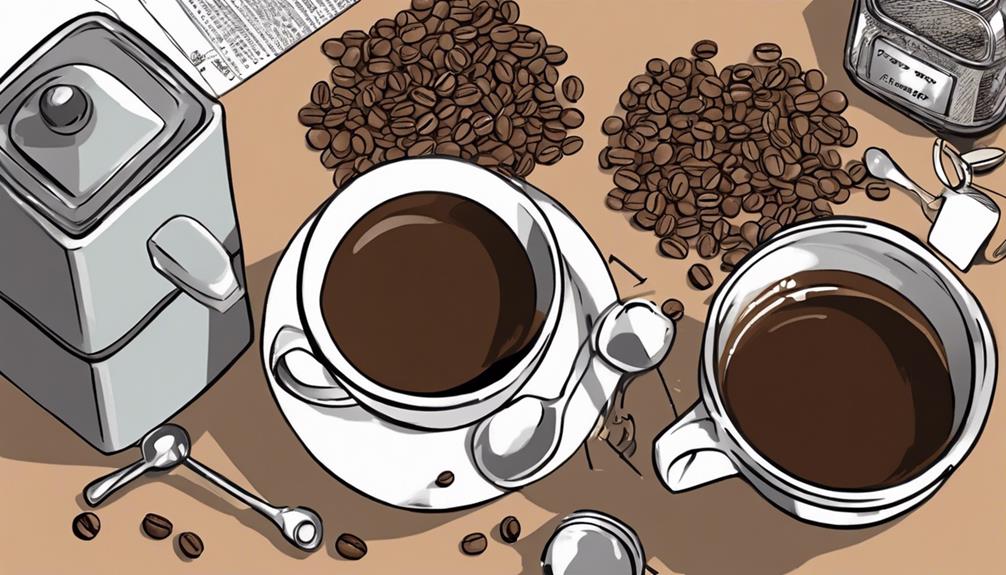
Determining the brew quantity of your Moka pot is vital for achieving consistent results with each brewing session. When figuring out how much coffee your Moka pot can produce, consider the following:
- Pot Sizes: Moka pots come in different sizes, typically ranging from 1 to 12 cups. Select a pot size based on your brewing needs to avoid wastage or the need for multiple brews.
- Maximum Fill Line: Most Moka pots have a clear indication of the maximum fill line inside the water compartment. Be sure not to surpass this line to prevent brewing issues.
- Cup Consideration: It's important to think about the number of cups you want to brew. Overfilling the water compartment can lead to uneven extraction and affect the quality of your coffee.
- Consistency: Each Moka pot size is crafted to deliver a specific amount of coffee. Understanding this guarantees that you consistently prepare the right quantity of coffee for yourself or guests.
Ensuring Proper Maintenance
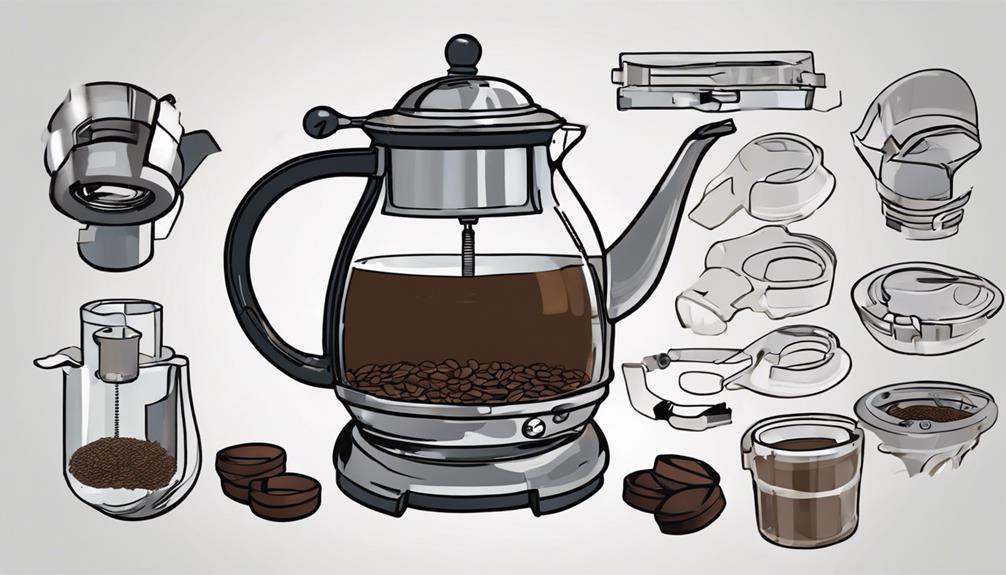
When maintaining your Moka pot, make sure you regularly inspect key components such as the safety valve and O-ring to prevent issues during brewing. Check the cleanliness of the safety valve to avoid blockages that can disrupt the brewing process. Additionally, inspect the O-ring and filter for any wear or damage that might compromise the seal necessary for proper brewing. It's important to use the correct size filter for the type of coffee you're making to ensure best extraction.
After brewing, assess the quality of your coffee by examining the compacted coffee grounds, known as the 'puck.' This can give you insights into your brewing technique and the grind size used.
To maintain your coffee maker effectively, wipe down the Moka pot after each use to remove any leftover water and coffee residue. Keeping your Moka pot clean and well-maintained will help you brew delicious coffee consistently.
Checking Safety Features
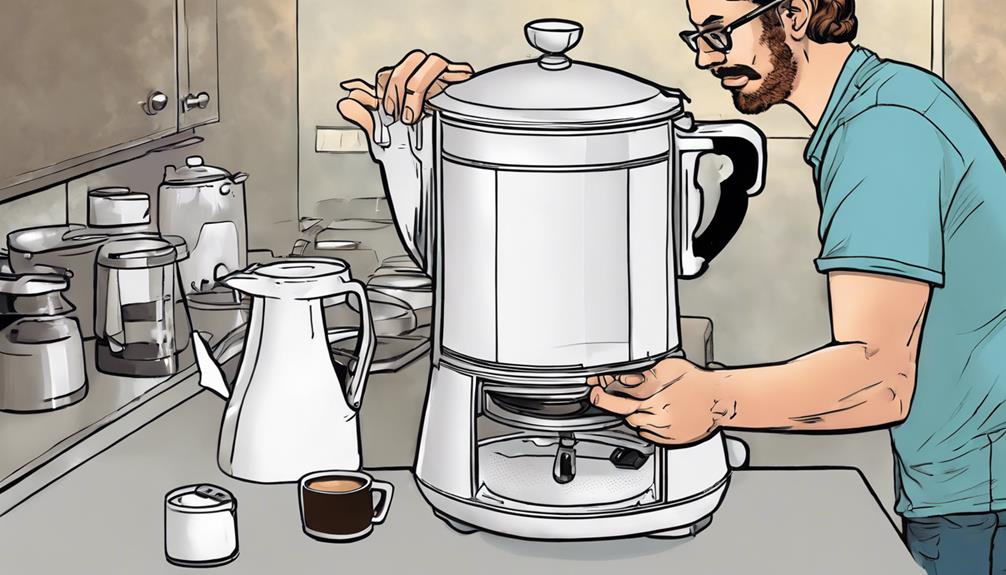
Regularly checking the cleanliness and functionality of the safety valve in your Moka pot is vital for guaranteeing a safe and efficient brewing experience. The safety valve plays an important role in preventing pressure build-up during the brewing process and releasing excess steam to maintain a secure environment while making your favorite coffee.
Here are some key points to keep in mind when inspecting the safety features of your coffee pot:
- Visual Inspection: Look for any signs of clogging or dirt buildup in the safety valve. Ensure it's clean and free from any obstructions that may impede its proper function.
- Testing Pressure Release: Conduct a pressure release test to verify that the safety valve is operating correctly. This ensures that steam can escape effectively during brewing, preventing any potential accidents.
- Regular Maintenance: Make it a habit to clean the safety valve after each use to avoid blockages and maintain its effectiveness in protecting your coffee-making process.
- Safety First: Remember, a well-maintained safety valve not only enhances the safety of your Moka pot but also contributes to the longevity and performance of your beloved coffee maker.
Selecting the Right Filter
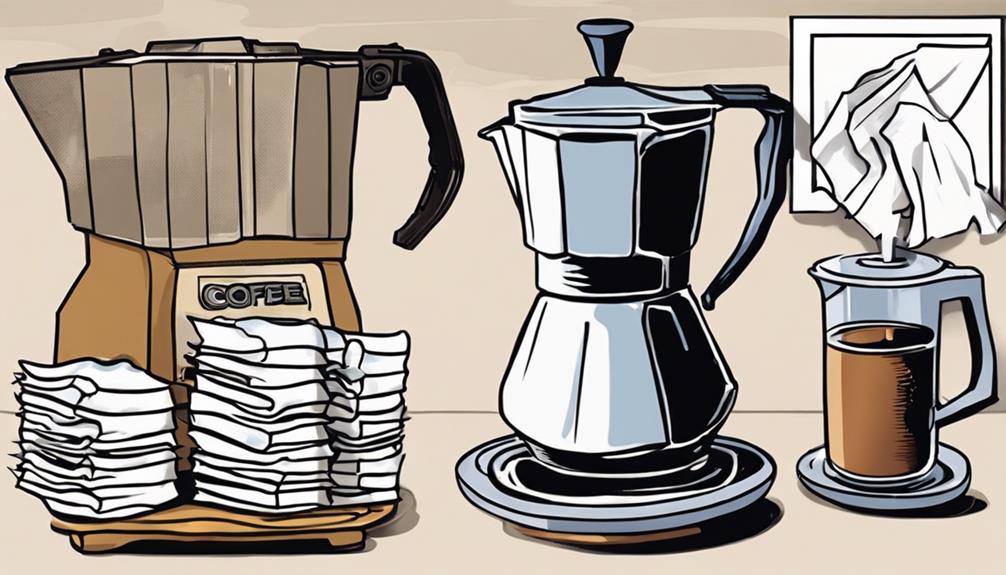
To ensure the best coffee extraction and a smooth brewing process, selecting the right filter for your Moka pot is necessary. The filter in a Moka pot has pinholes that allow water to pass through while brewing espresso powder. Choosing the correct filter size based on your coffee type is vital. Filters with larger holes are suitable for coarser coffee grounds, whereas filters with smaller holes are ideal for fine espresso powder. Ensuring your filter is well-maintained is key to a smooth brewing process and best coffee extraction. Regularly inspecting the filter for clogs or damages can help maintain the quality of your coffee.
| Filter Type | Coffee Ground Size |
|---|---|
| Larger Holes | Coarser Grounds |
| Smaller Holes | Fine Espresso Powder |
Cleaning and Storage Tips
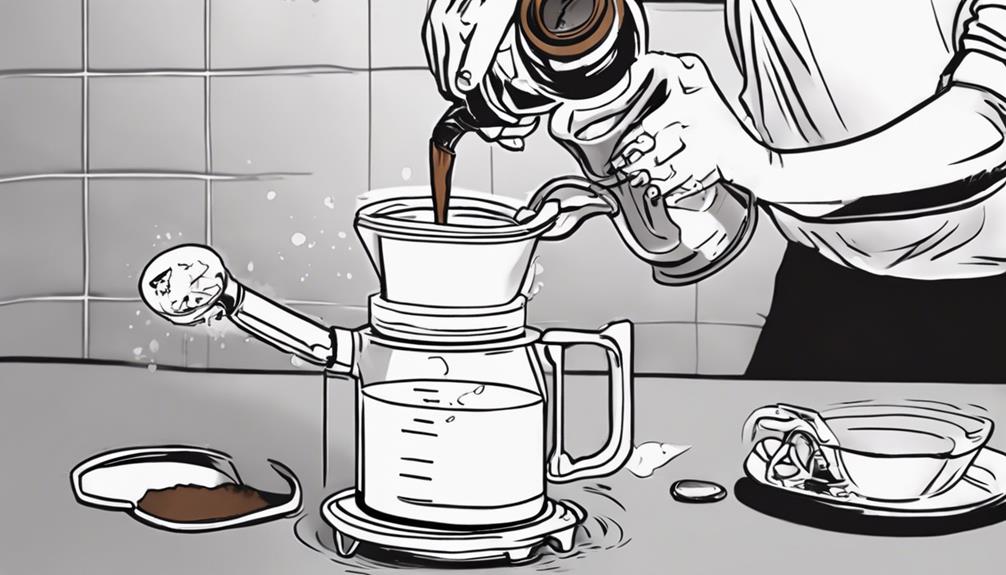
For maintaining the quality of your coffee and ensuring the longevity of your Moka pot, proper cleaning and storage are key aspects to consider. Follow these essential cleaning and storage tips to keep your coffee pot in top condition:
- Clean Thoroughly After Each Use: Disassemble the Moka pot and rinse all parts with warm water. Use a soft brush or cloth to scrub off any coffee residue from the filter and brewing chamber.
- Air Dry Completely: Allow all components to air dry completely before putting the Moka pot back together for storage. This helps prevent mold or mildew growth.
- Choose the Right Storage Spot: Store your Moka pot in a cool, dry place away from direct sunlight. Direct sunlight can cause damage or discoloration to the pot over time.
- Avoid Harsh Cleaning Agents: Refrain from using harsh chemicals or abrasive materials when cleaning the Moka pot. Opt for gentle cleaning methods to preserve its quality and longevity.
Frequently Asked Questions
How Do You Make a Pot of Coffee Step by Step?
To make a pot of coffee, start by filling the water compartment and adding fine espresso powder. Heat the pot slowly, letting the coffee ooze out smoothly. Once it flows like melted chocolate, pour and savor the rich brew. Enjoy!
How Much Coffee Do You Put in a Perfect Pot of Coffee?
To brew the perfect pot of coffee, you'll need 14-18 grams of finely ground coffee per cup of water. This golden ratio guarantees a flavorful and well-balanced brew. Experiment with different beans and grinds for your ideal cup.
How to Use a Coffee Maker Step by Step?
To use a coffee maker step by step, start by filling the water compartment to the pressure-release valve. Add fine espresso powder, heat on low, and brew for 2 minutes. When it oozes like melted chocolate, your coffee's ready to pour.
How to Make the Perfect Brewed Coffee?
Want to make the perfect brewed coffee? Use fine espresso powder, compact it into a 'puck,' heat the Moka pot slowly, brew for 2 minutes, and pour when it flows like melted chocolate. Enjoy!
Conclusion
Now that you've mastered the art of assembling a coffee pot step by step, you're ready to brew your way to pot perfection. Like a conductor leading an orchestra, you'll orchestrate the perfect cup of coffee every time. Next, why not try your hand at assembling a coffee plunger? With the same attention to detail and precision, you can create a once-in-a-lifetime cup of coffee that will satisfy even the most discerning palate. Just like with the coffee pot, follow the step-by-step instructions and soon you’ll be an expert at crafting the perfect cup of coffee using a plunger. Keep honing your skills and soon you’ll be regarded as a coffee connoisseur. Once you’ve perfected the art of assembling a coffee plunger, why not take your skills to the next level by assembling a coffee press? With the same level of precision and dedication, you can create a truly exceptional cup of coffee that will impress even the most discerning coffee connoisseurs. Follow the step-by-step instructions and soon you’ll be known for your ability to craft the perfect cup of coffee using a press. Keep exploring different coffee brewing methods and before you know it, you’ll be a master of all things coffee.
So grab your Moka pot, embrace the process with confidence, and savor each rich, flavorful sip. Your coffee journey is just beginning – enjoy the ride!

